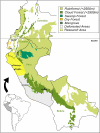Herbal mixtures in traditional medicine in Northern Peru
- PMID: 20226092
- PMCID: PMC2848642
- DOI: 10.1186/1746-4269-6-10
Herbal mixtures in traditional medicine in Northern Peru
Abstract
The investigation of plant mixtures used in traditional medicine in Northern Peru yielded a total of 974 herbal preparations used to treat 164 different afflictions. Psychosomatic disorders were, with almost 30% of all recipes applied, the most important afflictions treated. In most cases, healers used only one or two mixtures to treat an illness. However, up to 49 different preparations were used to treat the same disease. This indicates a high degree of experimentation. Altogether 330 plant species, representing almost 65% of the medicinal flora used in the region were applied in mixtures. The overwhelming number of plant mixtures contained 2-7 different plant species, although in the most extreme case 27 distinct species were included. The cluster analysis confirmed that mixtures used for applications like inflammations, infections and blood purification, as well as cough, cold, bronchitis or other respiratory disorders, or urinary infection and kidney problems had similar floristic compositions. Mixtures used for nervous system disorders, anxiety and heart problems often had a similar composition.
Similar articles
-
Medicinal plants used in Northern Peru for reproductive problems and female health.J Ethnobiol Ethnomed. 2010 Nov 1;6:30. doi: 10.1186/1746-4269-6-30. J Ethnobiol Ethnomed. 2010. PMID: 21040536 Free PMC article.
-
Medicinal plants used with Thai Traditional Medicine in modern healthcare services: a case study in Kabchoeng Hospital, Surin Province, Thailand.J Ethnopharmacol. 2012 May 7;141(1):193-205. doi: 10.1016/j.jep.2012.02.019. Epub 2012 Feb 17. J Ethnopharmacol. 2012. PMID: 22366679
-
Medicinal plants used by Burundian traditional healers for the treatment of microbial diseases.J Ethnopharmacol. 2015 Sep 15;173:338-51. doi: 10.1016/j.jep.2015.07.028. Epub 2015 Jul 29. J Ethnopharmacol. 2015. PMID: 26232628
-
Traditional uses of medicinal plants in gastrointestinal disorders in Nepal.J Ethnopharmacol. 2014 Dec 2;158 Pt A:221-9. doi: 10.1016/j.jep.2014.10.014. Epub 2014 Oct 18. J Ethnopharmacol. 2014. PMID: 25456430 Review.
-
A cross-cultural analysis of Jammu, Kashmir and Ladakh (India) medicinal plant use.J Ethnopharmacol. 2014 Sep 11;155(2):925-86. doi: 10.1016/j.jep.2014.06.029. Epub 2014 Jun 19. J Ethnopharmacol. 2014. PMID: 24952280 Review.
Cited by
-
The globalization of traditional medicine in northern peru: from shamanism to molecules.Evid Based Complement Alternat Med. 2013;2013:291903. doi: 10.1155/2013/291903. Epub 2013 Dec 28. Evid Based Complement Alternat Med. 2013. PMID: 24454490 Free PMC article. Review.
-
Antifungal and antioxidant activities of organic and aqueous extracts of Annona squamosa Linn. leaves.J Food Drug Anal. 2015 Dec;23(4):795-802. doi: 10.1016/j.jfda.2015.04.012. Epub 2015 Jul 26. J Food Drug Anal. 2015. PMID: 28911497 Free PMC article.
-
"Horchata" drink in Southern Ecuador: medicinal plants and people's wellbeing.J Ethnobiol Ethnomed. 2017 Mar 9;13(1):18. doi: 10.1186/s13002-017-0145-z. J Ethnobiol Ethnomed. 2017. PMID: 28279218 Free PMC article.
-
Valeriana rigida Ruiz & Pav. Root Extract: A New Source of Caffeoylquinic Acids with Antioxidant and Aldose Reductase Inhibitory Activities.Foods. 2021 May 13;10(5):1079. doi: 10.3390/foods10051079. Foods. 2021. PMID: 34068163 Free PMC article.
-
Natural material adsorbed onto a polymer to enhance immune function.Drug Des Devel Ther. 2012;6:209-16. doi: 10.2147/DDDT.S34622. Epub 2012 Aug 27. Drug Des Devel Ther. 2012. PMID: 22956861 Free PMC article.
References
-
- World Health Organization. Consultation Meeting on Traditional Medicine and Modern Medicine, Harmonizing the Two Approaches. Geneva, World Health Organization, (document reference (WP)TM/ICP/TM/001/RB/98-RS/99/GE/32(CHN)) 1999.
-
- World Health Organization. Traditional, Complementary and Alternative Medicines and Therapies. Washington DC, WHO Regional Office for the Americas/Pan American Health Organization (Working group OPS/OMS); 1999.
-
- World Health Organization. WHO Traditional Medicine Strategy 2002-2005. World Health Organization, Geneva; 2002.
-
- World Health Organization. Report, Technical Briefing on Traditional Medicine. Forty-ninth Regional Committee Meeting, Manila, Philippines, 18 September 1998. Manila, WHO Regional Office for the Western Pacific; 1998.
-
- United Nations Conference on Trade and Development. Systems and National Experiences for Protecting Traditional Knowledge, Innovations and Practices. Background Note by the UNCTAD Secretariat. Geneva, United Nations Conference on Trade and Development, (document reference TD/B/COM.1/EM.13/2); 2000.
Publication types
MeSH terms
Substances
Grants and funding
LinkOut - more resources
Full Text Sources
Medical


